Chengdu Travel Guide for the 2020 Dragon Boat Festival and Chengdu Hotel Recommendations-Chengdu Simshanju Hotel (Shaanxi Street Branch)
Tell me about this trip:
Chengdu is a calm and tranquil city with a long history and culture. The earliest impression of Chengdu comes from Du Fu's poem: "Looking at the red and wet place at dawn, flowers are heavy on the Jinguan City." Full of the humidity of the south, although the Shu Road is difficult to travel, the leisurely scenery of Jinguan City still makes people fascinated. Modern Chengdu people have given Chengdu new fashion vitality and made people linger. At the premiere ceremony of Wang Chaoge's new drama "Only Mount Emei", I came to Chengdu again and Mount Emei.
1. Preparations before departure:
1. The necessary ID card (student ID) for travel, as well as various valid certificates, cash, and credit cards.
2. Camera, memory card, charger. Mobile phones, chargers, and notebooks if needed. Develop the good habit of having paper and pens in your bag. These two things can be used at any time.
3. Clothing: Chengdu is hot in summer and cold in winter. It is enough to wear a T-shirt and coat in spring and autumn. The highest temperature in summer can reach 35℃, so attention should be paid to preventing heatstroke. The rainy season is mostly concentrated from May to July, and rain gear should be prepared when traveling.
4. In addition, sunscreen and moisturizer. Sunglasses, wet tissue, some cold medicine and motion sickness medicine are also recommended. Toothbrushes and toothpaste. Although these hotels all have them, it is still recommended to bring your own.
2. Transportation:
1. Airport bus.
Bus Schedule:

2. Airport subway.
Chengdu Shuangliu Airport has opened a subway, so you can take Line 10 to the city and transfer to Line 3. It is more convenient to go to Wuhou Temple, Chunxi Road and Panda Base. Especially during peak commuting hours, ground traffic congestion can be avoided.
Chengdu is known to be blocked by the city, and being able to travel by subway is the best choice.


3. Scenic spot through train
There are scenic spots through trains next to well-known scenic spots in Chengdu City, with trains every hour to distant places such as Panda Base, Sanxingdui, Jinsha Ruins, Qingcheng Mountain, and Anren Ancient Town. It can save the trouble of multiple transfers, which is quite good.
3. Accommodation:
You can usually travel back and forth on the same day when visiting scenic spots in Chengdu. Stay in Chengdu at night. I recommend a very distinctive hotel-Chengdu Simshanju Hotel (Shaanxi Street Branch)
Chengdu Simshanju Hotel (Shaanxi Street Branch) is located at No. 130 Shaanxi Street at the southwest corner of Tianfu Square in the center of the city. It is about 930 meters away from Metro Lines 1 and 2, about 327 meters away from People's Park, and about 350 meters away from Internet celebrity Heming Old Teahouse (inside People's Park), Gourmet Hoofs Street is about 290 meters away, wide and narrow alleys are about 1.3 kilometers away, about 1.8 kilometers away from Wuhou Temple Jinli, about 1.6 kilometers away from Chunxi Road, and 2.5 kilometers away from Taigo Rio. The geographical location is superior. Convenient transportation.
The hotel has 94 guest rooms of various types. In the hotel is a provincial key cultural relic-the Shaanxi Guild Hall, built during the Kangxi Period and written by Mr. Yu Youren. The ancient architectural style of more than 300 years complements modern fashion, full of ancient Shu culture. The charm allows you to sleep around the Chinese classical garden courtyard, where you can find tranquility in the hustle and bustle of the chaos and elegance.







4. Food:
I believe that Chengdu is more obsessed with food than any other place in our country. In Chengdu, eating is not only a need, but also a culture and temperament. In Chengdu, many people recommend newly discovered gourmet restaurants when talking. This atmosphere has also promoted Chengdu's ability to continuously innovate and update its cuisine. As one of the eight major cuisines, Sichuan cuisine is famous for its spicy flavor. There are various restaurants all over the streets and alleys in Chengdu. There are many snacks in Chengdu, including Dongzikou jelly, Tongguoxiang plain noodles, Tan tofu pudding, Shiyou noodles, and fat sausage noodles... I can't count it, and the price is very cheap.
5. Shopping:
Chengdu has Shu Brocade, one of the four famous brocades in China, and Shu Embroidery, one of the four famous embroideries. They have a wide variety of colors and high quality. They are a good choice for shopping in Chengdu. Vases, coffee sets, flower sets, rice bowls, etc. made of porcelain body bamboo are also very exquisite. In addition, there are Qingcheng silk carpets, tapestries, carpets, etc. If you like to drink, Chengdu's famous wines such as Luzhou Laojiao, Quanxing Daqu, Shuijingfang are also great choices for wine lovers.
6. Best tourist season:
The best tourist seasons in Chengdu are March to June in the first half of each year and September to November in the second half of each year. July and August are the hottest times of the year.
7. Itinerary Arrangements:
Day 1: Chengdu-People's Park-Wenshu Courtyard-Wangjianglou Park-Jiuyan Bridge-Jingjie Bar;
Day 2: Baoguo Temple-Fuhu Temple-Only Emei Mountain performed;
DAY1: Parks are the soul of this city

While walking, people are always keen to explore strange places. Wherever they go, the locals will always use "boring" to send tourists from afar. Perhaps it is habit that replaces the sense of freshness, and the touching remains in future generations. Only the soul of the entire city can be listened to. For Chengdu, Chengdu People's Park is the soul of the city.

People's Park carries the glorious and proud memories of the older generation of Chengdu people, because this park was one of the earliest parks opened in Sichuan and even China at that time. Every grass, tree, water and scenery in the garden record the tragedy and vicissitudes of Chengdu.

The People's Park has the elegance and calmness unique to Chengdu. The cultural corridor where we rest is composed of ancient poems related to Sichuan. In the morning and evening, men, women and old come here with their families to take a walk and eat digestion.
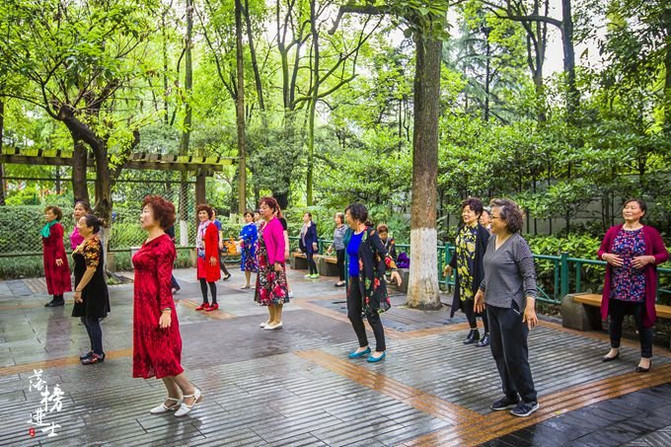
The lack of desire and desire in the land of Sichuan and Sichuan is vividly demonstrated here. The morning rain and dew have not yet completely evaporated, and many aunties have gathered in the small square to exercise. When the lights first turn on, the aunties have started the day. Compulsory course-square dance, a happy and confident smile can always attract countless people to watch.

The city park in my impression has a large square platform, artificial lake, rockery, and pavilions, while the People's Park is just the opposite. It does not seek to be large and wide in area. When you are in it, you can see all the winding paths leading to the secluded stone roads and lush green trees. There are also simple and elegant tile-house towers dotted in the forest. It is not a fairyland but it is more like a fairyland.

Viewed from this angle, it can be called a park built in the forest. The corridor is covered with lush trees. Wherever you walk, you can clearly feel the constant flow of oxygen coming from your face. The air is filled with fresh moisture, and you can even smell the aroma of the soil.

People's Park was originally called Shaocheng Park. This is because as early as the time of King Hui of Qin BC, Chengdu was divided into Taicheng (also known as Big City) and Shaocheng (Small City). People's Park was built on the boundary of Shaocheng, so it was named Shaocheng Park. After the liberation of Chengdu, it was officially renamed People's Park.

In this Sichuan-Sichuan city with a glorious red tradition, countless revolutionaries sacrificed their lives and blood here to save the nation from danger and ruin. In order to remember the outstanding contributions of our ancestors, the park also has a story gallery of Sichuan anti-Japanese generals and soldiers, Sichuan Army Monument to Soldiers and Soldiers, Sichuan Army Anti-Japanese War Documentary Exhibition Room, and Modern National Defense Science and Technology Art.

More than a hundred years ago, in order to commemorate the martyrs who died in the road protection movement, the Sichuan-Han Railway Corporation of the Republic of China built the "Monument to the Death of the Road Protection in the Autumn of 1911" in the park, integrating the art of Chinese and Western stone tablets and inspiring the passionate youth of a generation of Chinese people.

The Sichuan Road Protection Movement Historical History Exhibition Hall can be used as a dual use on the first floor of the Ginkgo Pavilion, hidden in the quiet and peaceful jungle. The martyrs who sacrificed their precious lives for the Road Protection Movement will also feel gratified when they see the degree of prosperity and peace.

Chengdu is known as the city of tea drinking. Today, as the pace of development is getting faster and faster, there is no city in China that is more leisurely than Chengdu. People's Park has the largest open-air teahouse in the country, with a cup of tea and a long bamboo chair., a red square table, and a day's leisure time is spent amidst the rich fragrant tea.

With the development of modern society, many old crafts have been nearly lost, but Chengdu's old crafts have not been concealed by the light of the times. Picking ears, drinking tea, and changing faces in Sichuan opera have deeply affected the lives of contemporary Chengdu people.

I like People's Park not only because of its superior ecological environment, but also because of the calmness and peace of mind integrated into the bones of Chengdu people. Only here, people don't have to chase the moving train or think about the pressure of life. What modern people lack most is the tolerance and open-mindedness revealed by People's Park?
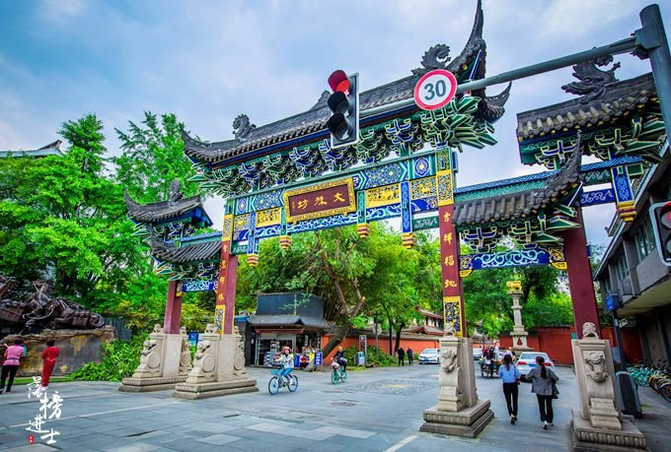
You don't go to Sichuan when you are young. The words used by your ancestors to warn their descendants are that Sichuan and Sichuan have a beautiful environment and rich and colorful life. Living for a long time can easily develop a lazy temperament. Although from a modern perspective, leisure is still the main tone of this city, busy is also an important color of Chengdu.

Most of the time, Chengdu's busyness and leisure are opposed. Only here can the opposing living conditions find a balance. This is the first of the four major Buddhist forests in the upper and lower reaches of the Yangtze River in China-Chengdu Wenshu Temple.

Wenshu Courtyard was built during the Sui Dynasty. Legend has it that the favorite concubine of Yang Xiu, the son of Emperor Wen of the Sui Dynasty, was built by the "Shengni" Xin at that time. Therefore, the original Wenshu Courtyard was named Xinxiang Temple. At the end of the Ming Dynasty, Xinxiang Temple was destroyed by military fire. Only 10 iron-cast statues of protecting the ring and two thousand-year-old fir trees survived.

During the Kangxi period of the Qing Dynasty, Zen Master Ci Du practiced ascetic cultivation between the two cedars of the abandoned ancient temple, and rebuilt the temple with the support of officials, gentry and civilians. The extraordinary Zen Master Ci Du showed signs of fire and auspicious signs during meditation. The common people found it magical and unbelievable. They thought that he was the "Manjusri Bodhisattva", so they changed their name to Manjusri Temple.

The so-called "hidden in the city" probably refers to holy places such as Wenshu Temple. Wenshu Courtyard is located in Qingyang District, Chengdu City, only 10 minutes away from Luoma City Shopping Center. The bells of the temple seem extremely harmonious and pleasant among the busy traffic in the city. Busy people always take time to come here to pick a stick of incense and seek peace of mind.

There are hundreds of years since the Kangxi period. The erosion of wind and rain has not changed the appearance of Wenshu Temple. It is as exquisite as it once was. The rebuilt Wenshu Courtyard presents a typical ancient architectural style in the Western Sichuan Plain. The houses are constructed of wood and stone, the wooden carvings of the column bases are exquisite and vivid, and the arch carvings reflect the ancients 'peak achievements in architectural decoration.
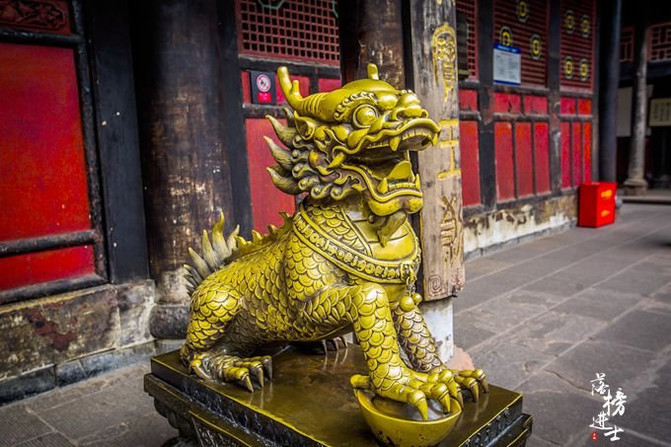
I have heard a lot about the name of Manshu Temple. Only by visiting it yourself can you experience its majestic momentum. Although it is a Buddhist temple, it is as gorgeous and exquisite as a palace. The architectural sculptures in the temple are all made by famous artists and have extremely high cultural relics value.

The fourth hall of Manshu Temple is the Shuanyin Hall. The base of the hall is the site of the ancient Xinxiang Temple and is mainly used for Buddha's sayings. The fragrance in the hall is faint, and the pleasant sound of wooden fish is faintly visible. The statue of Avalokitesvara is solemn and solemn. The large word "empty forest" is extraordinary. The Konglin stele inscription was made in 1702 from the ink of Emperor Kangxi's royal book, so the Wenshu Courtyard was also known as the "Konglin Hall".

In front of the Sutra Building is a place for Buddhist activities. The courtyard has a strong Buddhist meaning. The ancient trees on both sides block the sky and the sun. The three golden Buddha statues are solemn and solemn. It is said that when these three Buddha statues are viewed from different angles, the Buddha's expression will be slightly different. When viewed from a distance, they will be kind and kind, but when viewed up close, they will look solemn and inviolable.

The most eye-catching thing in the hall is the colorful picture of "Lion Roar" under the gold plaque of "Zhengfa Eyes". The lion is the king of all beasts and has the power to dominate the four directions. Buddhism uses this as a metaphor and symbolizes that Buddhism is like a lion king. The great wisdom of expelling the troubles of the world. The Burmese jade Buddha enshrined in the shrine is invaluable. It was recruited by the monk Xing Lin of Manshu Temple in 1922. After going through hardships, he walked to Myanmar to ask for his return. It is extremely precious.

Although Wenshu Temple is only a Buddhist temple, its significance has long exceeded this scope. It has become a good place for Chengdu people to worship Buddha, drink tea, chat, morning exercise, and bask in the sun. Different people can find a place to relax their hearts and minds in this courtyard.

Wenshu Temple strictly follows Chinese architectural philosophy and sits north facing south to ensure that Buddha can fully absorb the essence of heaven and earth. The five-fold main hall is located on the central axis opposite the gate. It has a regular layout and magnificent momentum. The five-layered temples are in turn the Tianwang Hall, the Three Great Earth Halls, the Daxiong Hall, the Shuanyin Hall, and the Sutra Building. The palaces are interconnected by corridors and dense columns, forming a closed courtyard building.
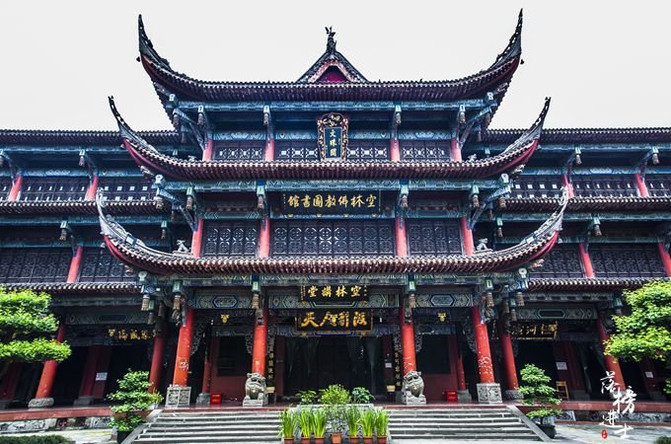
The Konglin Library is a professional library opened by the Wenshu Institute that mainly collects Buddhist classics, as well as books and periodicals of literature, history, and philosophy. The Sutra Tower is the building with the deepest cultural heritage of Manjusri. It was renovated during the Daoguang period. The entire hall is supported by 48 Gorge stone pillars. It has a width of seven rooms and a depth of four rooms. Most of the famous Buddhist relics, Arahat relics, Tang Xuanzang's top bone relics and the "Eight Views in the Empty Forest" are collected in the Sutra Depository.

The pines and cypresses are dense, the pagodas are towering, and cigarettes are rising among the red pillars and gray tiles. The bell of the temple puts the whole city into a peaceful and peaceful atmosphere. People who are busy as the norm will unconsciously slow down and pick up a stick of incense to record the lazy Chengdu time.

Since ancient times, most poets have come to Sichuan. Li Bai, Du Fu, Li Shangyin, Xue Tao, Su Shi and Lu You have all lived in Chengdu, leaving behind many unique songs through the ages. Among the many celebrities, Xue Tao's name is a little bleak hidden within it. Little did they know that the Wangjiang Tower located on the south bank of the Jinjiang River at Jiuyan Bridge was built in memory of this Tang Dynasty female poet.

In Wangjianglou Park, there are dense bamboo forests standing along the road. Walking into it is like walking through a long tunnel. The sun at the end guides people and slowly sees the bumpy life of this talented woman from Sichuan. Xue Tao was born in Chang 'an. When he was young, he and his family moved to Chengdu due to current affairs turmoil. Later, his father died of illness and his life forced him to become an official prostitute. Xue Tao is not only outstanding in appearance but also extremely talented. In the Tang Dynasty thousands of years ago, he was quite well-known. Later generations called her the "Four Great Female Poets of the Tang Dynasty" together with Yu Xuanji, Li Ye, and Liu Caichun, and called her the "Four Great Female Poets of the Tang Dynasty" together with Zhuo Wenjun, Lady Huarui, and Huang E.

Everywhere you can see in the park are all kinds of green bamboo. Xue Tao loved bamboo all his life. In memory of her, future generations brought various bamboos from all over the country to plant them in this garden. Today, there are more than 200 species of bamboo at home and abroad in the park, some of which are quite precious and rare. For thousands of years, these bamboos have grown silently, playing a unique heavenly sound for this infatuated woman amidst the rustling wind.

The rain wetted the road, the stone slabs gave off a warm light, and green bamboos were everywhere. The people seemed to be much more elegant. The scenery in the garden seemed to have been soaked in poetry.

As a female academic student with both talent and appearance, Xue Tao's talent and emotion have been famous for half of the Tang Dynasty. He has had contacts with many famous poets, including Bai Juyi, Liu Yuxi, Du Mu and other poetic leaders. Wei Gao, the military governor at that time, favored Xue Tao even more and even asked her to start the work of school books.

Xue Tao recited poems against the poets, sang and responded to poems, and exchanged letters. These people didn't hesitate to write and write to sing for her. During this period, Xue Tao picked streams of water and dyed the paper in ten colors including crimson, pink, and bright yellow, making it into a delicate, compact, easy-to-carry and communicate "Xue Tao Paper", which was widely popular for a time. There is a record: "During the Middle Tang Dynasty, Xue Tao, a Shu prostitute, made ten-colored small notes in Baihuatan for chanting. It was called Xue Tao notes at that time, also known as Shu notes."

In addition to Xue Tao, in addition to the bamboo forest, Wangjiang Tower is famous for its countless couplets. The two most famous paintings are on Wangjiang Tower. One of them is 212 words long, which uses the scenery to express the feelings, explains the past and the present in one go, and is still the first long couplet in the country. The other is even more famous because no one can correct the second line and become an "unsolved case". According to legend, this couplet was written by a scholar in the south of the Yangtze River in the Qing Dynasty when he climbed a building to look at the scenery-Wangjiang Tower, looking at the river, and Wangjiang Tower looking at the river. The river flow will last forever, and the river tower will last forever. After writing it, I felt quite literary and couldn't extricate myself from the artistic conception of the first couplet. I was not satisfied no matter how I wrote the second couplet, so I had to regret writing the first couplet on Wangjiang Tower. For more than a hundred years, this first couplet has attracted countless scholars to bow down.

This year marks the 130th anniversary of the opening of Wangjiang Tower. Wangjiang Tower was built during the Guangxu period of the Qing Dynasty. It was originally called Chongli Pavilion, which is derived from the meaning of "both beautiful and noble, and is actually called Chengdu" in Zuo Si's "Shu Du Fu" from the Jin Dynasty. Because the pavilion is located along the Jinjiang River, it is also known as the "Wangjiang Tower" and has now become a landmark building in Chengdu's famous historical and cultural city.

Looking from below, Wangjiang Tower looks like a woman dressed in full costumes, dressed in five colors, graceful and charming. The Wangjiang Tower is nearly 30 meters high and has an all-wood tenon structure with four eaves. The roof and bird roof on each floor are decorated with exquisite animal clay sculptures and figure carvings, with red pillars and green tiles.
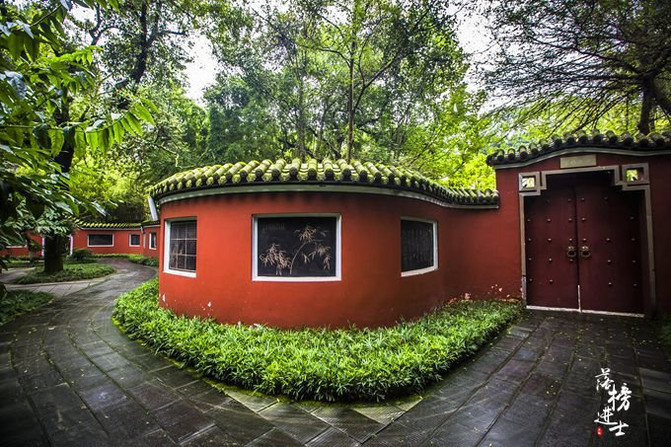
The entire park is set off by the bamboo, and Xue Tao's trace can be seen from time to time. Loquat Gate Lane, Zhuojin Tower, Xue Taojing, Huanjian Pavilion, Yinshi Tower, Wangjiang Tower... For this noble and lonely poetic soul, people have come all the way to her. The red gate is green with bamboo, the red walls and green tiles, and all the scenery becomes the background.

The building in front of you, which looks like a painted boat, is called Zhuojin Building. It was built during the Jiaqing period of the Qing Dynasty. It is named Zhuojin Building because it is adjacent to Zhuojin River, which is now the Jinjiang River. During the Ming Dynasty, this was a water terminal out of Sichuan. River towers sent guests off, Jinjiang boats sailed, and celebrities gathered here. Yang Sheng 'an once wrote the poem "The river goes upstairs, and the Jinjiang willows are high." Legend has it that Zhuojin Building was built to commemorate Xue Tao's farewell to close friends when he carried a boat and wine boat. Among these close friends, there was Yuan Zhen, whom she had loved wrongly all her life. After the two spent a beautiful and lingering year, this dedicated but affectionate scholar courtier finally abandoned her. Xue Tao, who had a bleak mind, wore a Taoist robe from then on, ignored the world, and lived a dull and lonely life of seclusion until his death.

Xue Tao Well, originally known as Yunujin, has sweet spring water and is suitable for making wine and paper. Because the King's Mansion of Shu in the Ming Dynasty used the well water to copy Xue Tao's notes, it was later mistakenly rumored that the notes made for Xue Tao himself was to draw from the well water here, so it was named Xue Tao Well. Although it was a misinformation and had little to do with Xue Tao, it was like a beautiful lie that everyone was willing to believe.

Although she was a woman with extraordinary talents, she was ultimately born as an official prostitute and could not be recognized by the world. Xue Tao was no exception. All his talent and brilliance were covered up by his inferior identity, and it was not until later generations that he was able to correct his name. Today, Xue Tao's tombstone is inscribed "Tomb of Xue Hongdu, a Book from Tang Girls 'School." After more than a thousand years of circulation, she has finally transformed from a delicate flower by the Huanhua River to a straight bamboo by the Jinjiang River.

The beautiful woman has passed away with the wind, and now no one cares if she is an official prostitute. She can write good poems, make beautiful notes, and she likes bamboo so much. She must be an elegant person. Then plant a bamboo forest and build a park so that this lonely soul can attach itself to it.
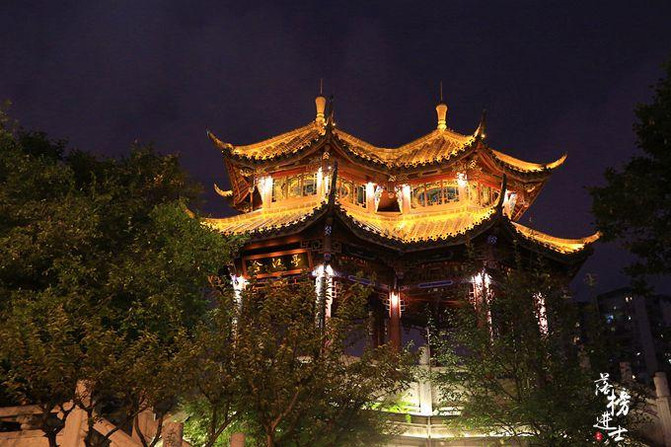
On the bank of Funan River, extending from Jiuyanqiao Wharf to Anshun Covered Bridge, is Chengdu's famous Jiuyanqiao Bar Street. The night was deep, and the Jiuyan Bridge was shining with neon lights. The moonlight and lights were blurred by the enthusiasm generated by the fireworks in the world, and a pavilion, two bridges, and many figures were vaguely revealed.

In the hearts of Chengdu people, the so-called Jiuyan Bridge has long been a place name and a bar culture. Jiuyan Bridge is in Chengdu, like Houhai is in Beijing. It is the gathering place for Chengdu's literary and artistic fan bars. In 2002, since the first bar, businesses continued to settle in. The Jiukong Bridge became increasingly plump at night, and more and more locals came here to find a taste of life.

Outsiders also come here because of their fame and want to explore the beauty of Jiuyan Bridge, but they don't know that the mountain they see may not be a mountain, and that the bridge may not be a bridge. The Anshun Covered Bridge across the Funan River in front of us is often mistaken for the Jiuyan Bridge. People "mistake Feng Jing for Ma Liang", but it does not affect the beauty of this bridge at all.

Anshun Bridge has a long history and is known as the oldest covered bridge in Chengdu. It is also the most beautiful place at night in Jiuyanqiao area. Marco Polo traveled around the world and recorded four bridges in China, one of which was the Anshun Covered Bridge. Nowadays, the stone carvings of the Qiaotou archway also record the past events of Marco Polo when he visited Chengdu.

In the daylight, the Anshun Covered Bridge does not attract special attention. Once the lights are turned on at night, the clearly dark bricks and tiles and the eaves that are tilted towards the sky seem to exude an indescribable magic, and they seem to be in the same space, but not at the same time.

Not far from Anshun Langqiao, located at the intersection of Fuhe River and Nanhe River, is the Hejiang Pavilion built during the Zhenguan period of the Tang Dynasty. The thousand-year-old pavilion shines brightly in the night. Ten pavilion pillars support the connected twin pavilions. The concept is extremely clever. Because of the word "he" in the name, people give the pavilion beautiful meanings such as a good marriage for a long time and a perfect marriage in the mirror. Many newlyweds take photos here-they wish to have one heart, and never leave each other with white heads.

Jiuyan Bridge is named after a nine-hole stone bridge. The ancient Jiuyan Bridge was built in the Ming Dynasty and has a history of more than 400 years. The bridge was demolished in 1992. The Jiuyan Bridge that people see today is a steel-frame cement bridge built in 1988. The number of bridge holes far exceeds 9, which can be said to be beyond its name. Even so, the Jiuyan Bridge hidden by the night is still charming. The river surface was illuminated by lights, and the water surface was like a undulating canvas, covered with fine and crazy oil paint, which was illusory and real, seemingly real and illusory.

"Silk pipes are growing day by day in Jincheng, and the wind is halfway into the river and halfway into the clouds." The tranquility brought by the fall of night alone circumvents the Jiuyan Bridge, and the lights on the bar street turn on one after another, making it very lively to sing and dance. Most of the bars in Jiuyanqiao originated from bars near Sichuan University. Most of them are students, teachers, poets and artists. They have a strong humanistic atmosphere and full of literary and artistic style.

No matter what the weather is, when the moon climbs up, the bar street is always full of traffic and colorful. Hundreds of bars have dressed Jiuyan Bridge up in a colorful manner. Most of the bars here have open-air slots. Whether you sit outside to watch the river view and drink a drink, or sit indoors to listen to music and chat, it is very comfortable.

Isuke Bar is a "time-honored brand" on this street and has been open for nearly 15 years. In 15 years, a bar has long changed from a place to get drunk to a place of feelings. The first thing to enter is a small courtyard. The music is fluttering and not noisy. Drinking and chatting are not affected at all. Sitting in the courtyard, you can also watch the projection in the evening breeze. On nights with sports events, the place will be even more lively.

The interior of the bar is decorated elegantly and exquisitely, and the old style is vaguely visible. The singer was full of deep affection, and seemed to be murmuring his own story while singing softly. The resident singers in Jingjie Bar are all of high standards. It is said that Yu Kewei and other singers have also sung here.
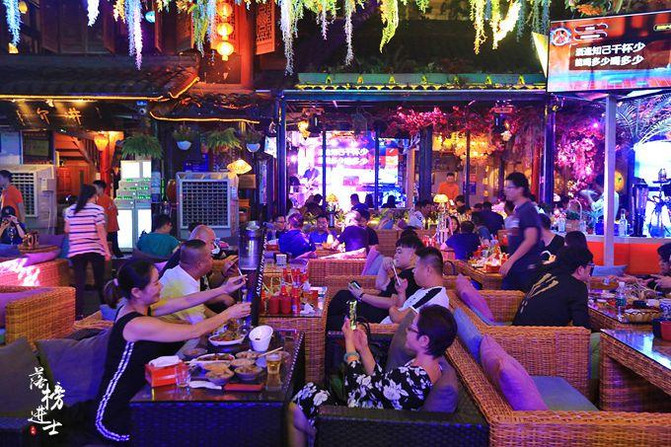
The deeper the night, the stronger the atmosphere. The restraint when I first sat down has long been diluted by alcohol. At this time, the bar is excited and full of emotions. The chatting people worked together to create a meaningful sound in the dimly lit bar.

Singers use music to express their emotions, and people find resonance in songs. Comfortable sofa chairs and low glass square tables, groups of three to five have a few drinks, or talk to each other in pairs.

The beautiful lights gave off warm light, the light and shadow swayed gently around people, and the singing sounded slowly and melodious, swallowing the din of the bar. The time at this moment was so soft.

With the help of alcohol and specific environments, people release stress and depression. Drink without getting drunk, wander between dreams and reality, and turn around and leave.

Bars are like the hometown of urbanites 'souls, opening at dark and closing at dawn. Between night and day, not only time passes by. People with like-minded interests, people who pity each other in the same illness, and people who refuse to admit defeat support and comfort each other and spend a wilderness of life.

Young people drink to be lively, and middle-aged people drink to relieve their worries. Either way, tonight, I don't care about humans, only about you around me.

"I forgot what I said for a while, and I talked in my dreams." Day after day, many people are fascinated by the night of Jiuyan Bridge. In Chengdu, the night is still late.
DAY2: Wang Chaoge's "Only Mount Emei" premiered in the world. It takes six days to watch the entire play

When you come to Chengdu, many people will come to Mount Emei. I have been to Mount Emei and know all about Baoguo Temple. There are many ancient temples on Mount Emei, and Baoguo Temple is the first of the many. Tourists who set out for a pilgrimage to the top of Mount Emei all "start with one step" here. The location of Baoguo Temple is not very clean. There is a road in front of it, and 50 meters away is the back door of Southwest Jiaotong University. The large plaque of "Baoguo Temple" with gold characters on a black background on the mountain gate is the imperial inscription of Emperor Kangxi, taking the meaning of "Serving the Country and the Lord's Grace" in the Buddhist scripture "Four Engences and Four Reventions".
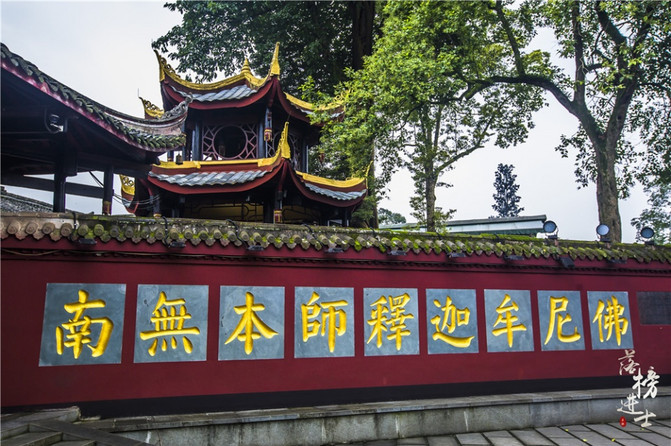
Baoguo Temple was built in the forty-third year of Wanli of the Ming Dynasty and has a history of more than 400 years. The original name is "Huizongtang", which takes the meaning of "three religions" of Confucianism, Buddhism and Taoism. Later, Buddhism flourished, forcing the first two out. During the Kangxi period of the Qing Dynasty, this place was changed from "hall" to "temple" and has been used to this day. A pair of stone lions in front of the temple is said to have been carved in the Ming Dynasty. They are exquisite and vivid in shape, powerful and majestic. They guard famous mountains and ancient temples day and night like guards.

After entering the gate, this noisy temple seemed to have entered another world-solemnity, tranquility, and swaying fireworks. The people in the temple seemed to have their own thoughts on their own. In front of the red candles and on the wishing sign, they silently recited their mixed thoughts with the curling of green smoke. The red candle shines, the green smoke rises, and a trace of warmth unique to the world slowly rises.

Different from ordinary temples, Baoguo Temple does not sit north facing south, but sits east facing west, welcoming the rising sun in the morning and sending off sunset at night. From the front, Baoguo Temple, built against a mountain with flying eaves and raised corners, looks like a phoenix spreading its wings in the jungle and ready to fly. The couplet inscribed on the pillars on both sides of the mountain gate is "Phoenix spreads its wings to the golden watchtower, and bells and chimes fall down on the jade steps" is a vivid description of the "phoenix" of Baoguo Temple.

There are four courtyards in the temple, one courtyard and the other sky. The main halls are Maitreya Hall, Daxiong Hall, Seven Buddha Hall and Samxian Hall. They are advanced layer by layer, and each weight is higher than the last, which naturally gives rise to majestic momentum. The drizzle fell brightly, and the trees and flowers were washed more beautifully by the rain. The gray tiles in front of me turned black. After more than 400 years of time, there was no trace of rot, only a breathtaking cleansing and solemnity.

All the way up, passing through Maitreya Hall and Daxiong Hall, climbing the stone steps to reach the third hall and the seven Buddha halls. There are seven Buddhas enshrined in the temple, one in the middle is Sakyamuni Buddha, and the other six are past Buddhas. From right to left, they are: Nanwu Detention Sun Buddha, Nanwu Junahanmuni Buddha, Nanwu Kaya Buddha, Nanwu Vishe Buddha, Nanwu Shiyi Buddha, and Nanwu Visha Buddha.
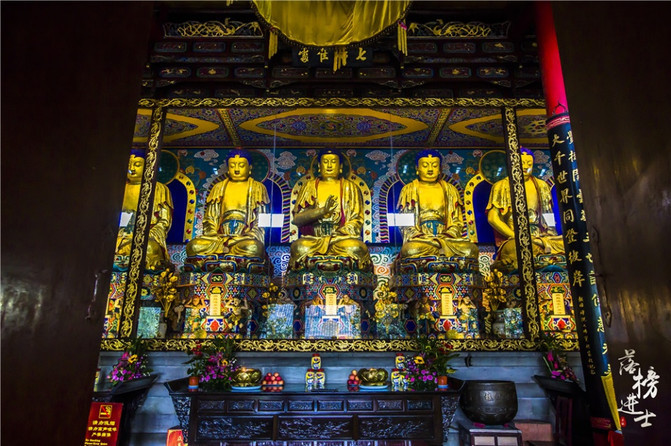
All the seven Buddhas sat cross-legged on the lotus platform, looking calm, their eyes slightly closed, and they did not speak a word. The dim hall forms a sharp contrast with the resplendent Buddha's body, as if in the darkness, the place where the Buddha is present is the only bright direction. If you don't look carefully, the seven Buddhas seem to have similar shapes. When you look carefully, you will find that they have different expressions and different gestures, and each is beautiful.

Although it has taken a long time, the carvings on the stele are still lifelike. The picture is smooth with the pen, bright in colors, and the characters are quite delicate. Every detail is carefully carved. These stone tablets made in the Ming and Qing Dynasties must have been carved manually with strokes. The stonework depicted has impressive skills and artistic perception.

The splendid Wei Tuo Station statue is wearing armor, holding the mountain with its right hand and pressing the Vajra Demon Subjugating Pestle with its left hand. It has trimmed eyebrows and phoenix eyes, and its lips are tightly closed. It is powerful, strong, and upright.
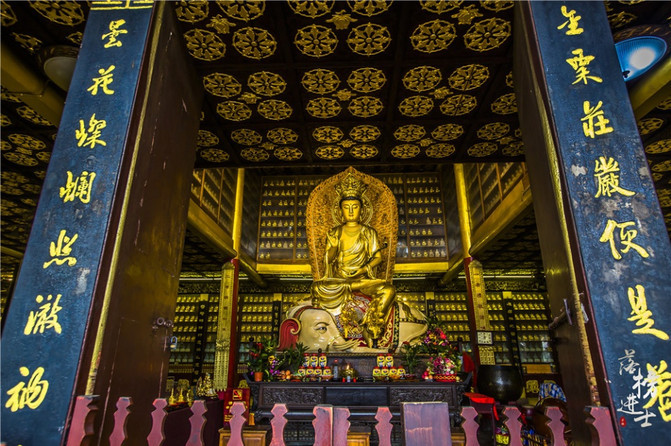
Because Mount Emei is the ashram of Samantabhadra Bodhisattva, Samantabhadra Temple is located in the last hall of Baoguo Temple. Samantabhadra Bodhisattva's golden body rode on a white elephant, looking kind and kind.

Walking in the temple, tourists pass by from time to time, but the temple always gives people a sense of tranquility. The painted wooden piles and the moss covered stone lions all exude indescribable magic... The long bell rings, whose wishes pass with the wind, whose prayers are answered.

There are many immortal mountains in Shu, but the mountains of Emei are difficult to match. When I arrived at Mount Emei, I thought of Guo Xiang, Zhou Zhiruo, Abbess Extermination, and Bai Niangzi... The only nunnery on Mount Emei was Fuhu Temple. So back then, Guo Xiang, Abbess Extermination and Zhou Zhiruo probably cultivated here. Of course, this is just a joke, but I have to admit that the characters derived from the novel are so vivid, which really adds a lot of fantasy to this mountain and this temple.

Fuhu Temple is one of the many temples on Mount Emei. It is not far adjacent to Baoguo Temple, but it has a strong incense and a quiet and elegant place. The temple was built in the Jin Dynasty and was called the Medicine Master Hall at that time. It was renamed several times and was finally designated as the "Fuhu Temple". "Fuhu Temple" is named because the mountain shape is like a crouching tiger, and because there are many tiger disasters in the mountains,"Zunsheng Building" was built to suppress tigers. Today, all the bhikshunis on Mount Emei are concentrated in Fuhu Temple, which has also become one of the largest bhikshuni Taoist temples in China.

Climbing the "Bujinlin" wooden workshop, Fuhu Temple is close in front of you. "Bujin Forest" is a forest planted by monk Ji Wan of the Qing Dynasty according to the number of words in the "Mahayana Sutra", with a total of more than 109,000 trees. This is a mysterious ancient forest that spans between Fuhu Temple and Baoguo Temple. Deep mountains, secluded forests, and ancient temples are independent.

Fuhu Temple has gone through thousands of years and has been renovated several times. Most of the buildings in the temple are mottled with red paint and heavy moss marks, looking like they have experienced many vicissitudes. Entering the temple gate, you will first arrive at the Maitreya Hall, which is dedicated to the sitting statue of Maitreya Buddha with a big belly and a golden clay sculpture.

Fuhu Temple is surrounded by a cloth gold forest. Various cypress and southern trees are so dense that they cover the sky. Walking while you are walking, you feel like "still faint in the day". However, although the trees are much taller than the temple, there is not a single dead branch or leaf on the roof of the temple all year round. Every leaf falls, it will be blown away by a mountain breeze before it reaches the roof. Emperor Kangxi Xuanye learned of this and awarded the title of "Ligou Garden" to the ancient temple and meditation forest. Although this rare scenery is caused by the special terrain where the temple lives in the middle of the mountain, this divine stroke of nature still makes people admire.

Walking through Maitreya Hall and continuing upwards, the second hall will reach the Samantabhadra Hall, where the golden body of Samantabhadra Bodhisattva is enshrined.

The Daxiong Hall is the last hall in the temple and was renovated in the eighth year of Shunzhi in the Qing Dynasty. The temple enshrines three-body Buddhas, namely, Dharmakaya Buddha, Reven-Body Buddha, and Ying-Body Buddha. Although there are three bodies, they are actually one Buddha, with a glorious golden body and a solemn Dharma. Red wish ropes are hung in front of the Daxiong Hall. People in the world always have too many worries and desires. I was annoyed but couldn't help but ask for it, so I had to place my hopes on the god who looked up three feet high.

There is a simple pavilion in the back courtyard on the right side of the Daxiong Hall, called Huayan Tower. There is a copper Huayan Tower cast in the Ming Dynasty. The tower is 5.8 meters high and has a total of 14 floors. The body of the tower is engraved with more than 4700 small Buddha statues. The body of the tower is engraved with the full text of the "Huayan Sutra". The Huayan Copper Tower ranks among the most copper towers in China for its long history, tall body and well-cast. Looking at the exquisitely carved and lifelike Buddha statues on the copper tower, the ancient people's craftsmanship is as skillful as nature, which makes people admire and admire them.

The building in front of him was mottled, and the steps were covered with green moss. It had been resting for an unknown amount of time. The thousand-year-old temple has left many monuments, showing a profound sense of time. People stepped in gently, afraid of shattering the silence of the mountain.
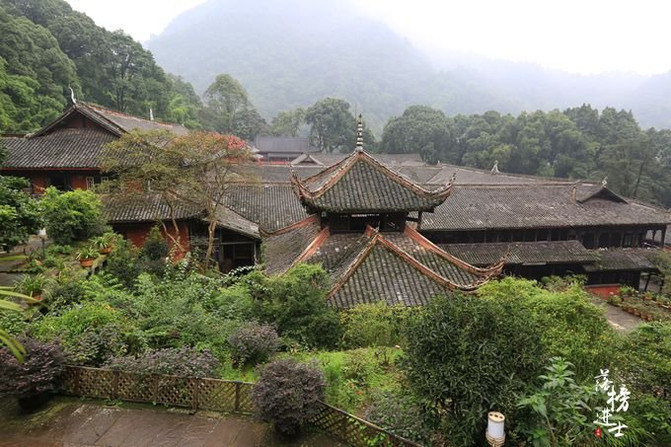
The mountains are lush and lush, with rippling green waves and boundless. The small green tiles, wooden skin roofs and plain ridges of Fuhu Temple are looming amidst the clouds and mist. The nanmu trees are beautiful and tall, creating a quiet and clean atmosphere.

Arhat Hall is located at the highest point of Fuhu Temple and houses 500 Arhats. It was first built in the Qing Dynasty and was later destroyed. It was rebuilt in 1995 and opened to the public in 1999. From then on, the incense burner in Luohan Hall was surrounded by cigarettes and fireworks continued every day.

It is said to be a five-hundred arhats hall, but there are only 499 arhats in it. It is said that the master who created the arhat was also an arhat, so the five hundred arhats in everyone's mouth include this master.

Whether it is Guo Xiang, Zhou Zhiruo, or Bai Niangzi, they are just legendary figures. If what really makes Mount Emei rich in legend, it is the ancient temples and temples that truly exist in this mountain. It is hidden among 100,000 dense forests and sits quietly like a bell in the river of time. It has never changed for thousands of years.

At the foot of Mount Emei, dreams and clouds, fairyland and the world are intertwined. Hesitation, restlessness, passion, but still calm, are like a flowing feast, revealing the joy and sadness, cruelty and warmth of human life. On September 6, director Wang Chaoge's latest work "Only Mount Emei" was performed globally at the foot of Mount Emei. The "Above the Cloud" situational experience theater, the "In the Cloud" garden theater, and the "Under the Cloud" real-life village theater together form a magnificent and fantasy "drama fantasy city". Here, other people's lives enter the audience in a way that is within reach. Everything is no longer just watching from the sidelines, but empathy.

The stories in "Only Emei Mountain" come from professional backers who have lasted for thousands of years, from Gaohe Village, Chuanzhu Town, which has a history of hundreds of years, and from ordinary villages 20 years after the reform and opening up... Behind the new forms of artistic expression, what remains unchanged is people, life, and the destiny and choices faced by generation.

There are 117 acres of large-scale theater complex, 500,000 tiles, 6 major performance spaces, 395 rooms, and 4355 old objects. The audience has no idea where they have become people in the drama, and they touch every hidden detail based on their respective reactions. It may be a small piece of paper, a letter, or even a bowl of green tea or a bite of bacon. And every trivial choice people make determines the direction of the plot. Just like life, every choice hides a great change in destiny. It was just that when people were standing at the intersection of Sancha Road, they couldn't escape the ordinarity of daily life and thought it was just the most ordinary day in their lives.

Life cannot be repeated again, but here is the wrong time and space. There is no beginning and no end. As long as you are willing, even if you swear to check in all randomly triggered plots, this fantasy city will stay with you to the end.
"In the Cloud"-Garden Theater

"Above the Cloud"-Situational Experience Theater

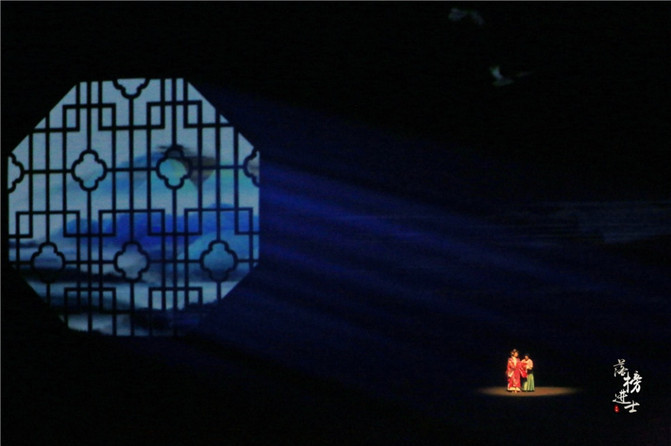
The six major performance spaces of "Above the Cloud" include a semi-outdoor space and five indoor theaters. Each game can accommodate 1400 people. The audience watches the performance in a marching manner, shuttling through time and space, and shuttling through different stories. The "Above the Clouds" theater has many sea scenes. When people really climb the golden roof and stand on the sea of clouds, they can overlook the world, the years, life, and everyone's life in the world.

Above the cloud, we have created a place where our souls can "leave our bodies" outside the impetuous society, allowing people to immerse themselves in it without knowing the world, the whole time, and who they are.


"Under the Cloud"--Real-life Village Theater
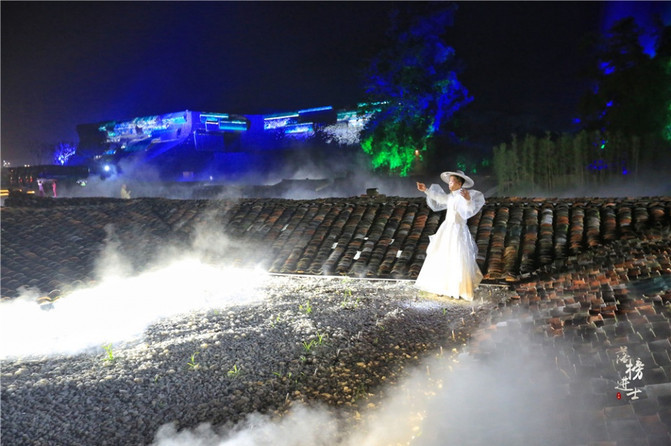
The original style of the real-life village immersively restored the life stories full of fireworks and the indelible nostalgia of parting for the audience. It consists of 48 private houses, 395 rooms, 27 courtyards, and 104 micro-dramas, totaling 20,000 square meters.

These houses were once to be demolished and renovated, but now they have become a "scenic spot", attracting tourists and spectators.

When people shuttle through the village, they are not only absorbing the nutrients given by drama, but also experiencing a process of placing childhood and nostalgia.

Maybe you have been away from the land for a long time/Maybe you have been away from the salty water for a long time/Maybe you have been away from the fire pond for a long time/Maybe you have been away from the crunching bamboo benches for a long time/Maybe you are eager to finish what you are doing quickly/Maybe you are eager to go back to a more fashionable, more gorgeous and richer city/That's all right/But it just so happens that you and this small village are accidentally bumped into each other. (Excerpted from "Only Mount Emei" Under the Cloud)

Everyone has a different interpretation of nostalgia, but the most important thing is that nostalgia occupies an important part of everyone's heart. In the past, people always said that nostalgia was a hindrance, and it was often more heavy and shackles. However, what the audience sees here is that there is no conflict between nostalgia and people's desire to find a new life.

In the old village "under the clouds", villagers are struggling with whether to leave the declining countryside and move towards the "fragrant" big city. It doesn't matter, you can leave if you want, stay if you want, and go back if you want. There will be no resentment for nostalgia. It will turn into the morning glow on the horizon, it will turn into the tiles of the eaves, and it will always be there. No matter how you choose, live actively, be grateful, and embrace hope, the world will be worth it. (End of the full text)
Previous Article:Travel guide to Chengdu in 2020. Don't want to leave until the "chrysanthemums" are open
Next Article:Trend Play Bashu Chengdu Chapter
